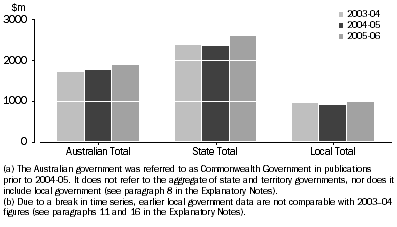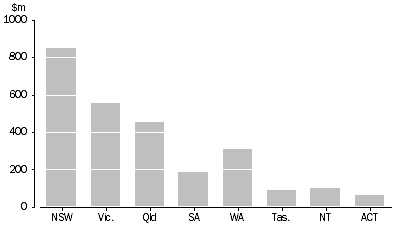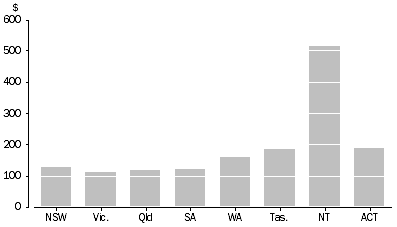NOTES
ABOUT THIS PUBLICATION
This publication contains estimates of Australian public funding for arts and cultural activities, facilities and services for the three years from 2003-04 to 2005-06. Estimates for the three levels of government have been compiled from administrative by-product data obtained by the Australian Bureau of Statistics (ABS) from annual reports and budget papers, and from information provided by selected Australian Government authorities (including the Australia Council), state and territory governments and local government authorities. Detailed estimates of local government funding of arts and cultural activities are not available for this edition of this publication but are expected to be available for a future edition, when the ABS begins to classify local government data by a more detailed Local Government Purpose Classification.
Funding data in this publication are aligned, where possible, with the categories specified in the Industry Classification of the Australian Culture and Leisure Classifications (cat. no. 4902.0), which were released in 2001. Cultural activities have been classified into two major groups: Heritage; and the Arts.
INQUIRIES
For further information about these and related statistics, contact the National Information and Referral Service on 1300 135 070 or Damian Sparkes on Adelaide (08) 8237 7425.
SUMMARY COMMENTARY
CULTURAL FUNDING
Total government funding for cultural activities was $5.4 billion in 2005-06 ($5,449.7m), a rise of 9.1% on the previous year. The Australian Government contributed $1,878.4m (34.5%) of the total cultural funding and the state and territory governments contributed $2,598.1m (47.7%). Local governments provided $973.2m (17.9%).
Broadcasting and film continues to be the largest recipient of funds, with funding of over $1.2 billion ($1,217.7m or 22.3% of total cultural funding) from the Australian Government and state and territory governments combined. This was a 4.3% increase on the $1,167.1m allocated in 2004-05. The other major recipients of federal and state and territory government funding in 2005-06 were Nature parks and reserves ($1,091.5m representing 20.0% of total cultural funding); Libraries and archives ($575.8m, 10.6%) and Other museums ($506.1m, 9.3%).
Changes over time
Between 2004-05 and 2005-06, the Australian Government contribution to cultural funding increased by $117.5m, a change of 6.7%. State and territory government contribution to cultural funding also increased, with the 2005-06 total up 11.1% ($259.5m) on 2004-05. During the previous period (2003-04 to 2004-05) cultural funding by the Australian government increased by $61.5m (3.6%) while the contribution by the state and territory governments fell $24.1m (1.0%) during the same period.
Cultural Funding, By level of government
- 2003-04 to 2005-06

In terms of dollar value, the major recipient of cultural funding by the Australian Government was Broadcasting and film, which received $1,141.3m in 2005-06 compared to $1,096.5m in 2004-05, an increase of $44.8m or 4.1%. The only categories that received less funding by the Australian Government in 2005-06, when compared to 2004-05, were Community cultural centres and activities (a fall of $1.8m), Zoological parks, aquaria and botanic gardens (-$1.0m) and Performing arts venues (-$0.1m).
The total state and territory government funding for Nature parks and reserves received the largest increase, rising 10.4% ($95.4m) to $1,016.3m in 2005-06. Funding for Art museums reached $214.0m, an increase of $43.3m (25.3%). The state and territory governments also significantly increased funding for Libraries and archives, up $43.1m (10.8%) and Zoological parks, aquaria and botanic gardens (up $31.5m, 23.9%). The only category that received less funding by the state and territory governments in 2005-06, when compared to 2004-05, was Literature and print media which fell by $0.5m (9.9%).
RECURRENT AND CAPITAL EXPENDITURE
Recurrent expenditure refers mainly to expenditure on wages and salaries, purchases of goods and services, and current grants and subsidies. In 2005-06, recurrent expenditure was $4,813.0m or 88.3% of total cultural funding. The Australian Government allocated $1,848.6m (98.4%) of its cultural funding towards recurrent activity, whereas state and territory governments provided $2,114.7m (81.4%) and local governments contributed $849.7m (87.3%).
Capital expenditure is primarily on the creation of fixed assets and on the acquisition of land, buildings and intangible assets. In any one year, the amount of funding for cultural activities can be affected by high levels of one-off capital expenditure. The total capital expenditure by all levels of government was $636.7m in 2005-06, a rise of 31.7% on 2004-05. In 2005-06 the majority of the nation's capital expenditure was by the state and territory governments who, collectively, outlaid $483.4m (75.9% of the total). Local governments spent $123.5m (19.4%) on capital expenditure and the Australian government outlaid $29.8m (4.7%).
FUNDING BY LEVEL OF GOVERNMENT
Australian Government
In 2005-06, the Australian Government allocated the majority of its cultural funding to support Arts activities ($1,406.2m) or 74.9%, while Heritage activities received $472.2m. The majority of Australian Government Arts funding (81.2%) was attributed to Broadcasting and film ($1,141.3m). For Broadcasting and film the main recipient was Radio and television services which received $1,000.6m (71.2%). The largest recipient of Heritage funding was the Other museums category which was allocated $199.6m (42.3%).
State and territory government
The state and territory governments traditionally direct the majority of their funds towards Heritage activities. In 2005-06, the state and territory governments allocated $2,142.1m, or 82.4% of their cultural funding for Heritage activities. Of the states Tasmania had the highest proportion of cultural funding allocated to Heritage activities (93.3%) followed by Queensland (86.9%). Arts activities received $456.0m of the total cultural funding by the state and territory governments with the majority of Arts funding allocated to Performing arts venues ($183.7m) . Of this funding for Performing arts venues the New South Wales government accounted for 60.3% ($110.8m).
STATE AND TERRITORY GOVERNMENT CULTURAL FUNDING, By value of funding
- 2005-06

Across all categories, the largest recipient of state and territory government funding was the Nature parks and reserves category which received $1,016.3m, accounting for 47.4% of Heritage funding and 39.1% of the total cultural funding. Other major recipients were Libraries and archives ($441.7m), Other museums ($306.6m) and Art museums ($214.0m).
Local government
In 2005-06, local government funding for cultural activities was $973.2m, which was 17.7% of total cultural funding provided by all levels of government. This was a rise of $75.5m or 8.4% on 2004-05 when local government funding for cultural activities was $897.7m. Over a third of local government funding was provided by NSW local governments, where funding was $330.2m (33.9%).
FUNDING PER PERSON
Government cultural funding per person increased for all levels of government in 2005-06. The total per person funding, for all levels of government in Australia was $275.90 in 2005-06, a rise of $25.79 from the 2004-05 figure of $250.11. The Australian Government per person contribution to cultural funding increased to $95.10 in 2005-06, a rise of $6.96 from 2004-05 ($88.14).
STATE AND TERRITORY GOVERNMENT CULTURAL FUNDING, By $ per person
- 2005-06

The total state and territory government contribution rose by $14.49 per person, from $117.05 in 2004-05 to $131.54 in 2005-06. Of the states, Tasmania had the highest expenditure, per person, for cultural funding ($186.42) followed by Western Australia ($160.71). Victoria had the lowest cultural funding per person ($113.12). Expenditure per person was significantly higher for the Northern Territory ($516.67) and the Australian Capital Territory ($187.86).
Funding for Nature parks and reserves was the largest component of per person expenditure for all regions except the Australian Capital Territory. The Northern Territory expenditure on Nature parks and reserves was $298.96 per person. Tasmania ($80.10) and Western Australia ($62.22) were also well above the national average of $51.45 per person.
Another major component of state and territory government expenditure was for Libraries, where the national average was $19.95 per person ($394.0m in total). The Northern Territory Government ($60.05) and Australian Capital Territory Government ($59.43) spent the most per person, but this is partly because libraries are generally funded by local governments in the other states. Tasmanian expenditure was also well above the national average at $49.02 per person.
On a per person basis, the average value of local government funding was $49.27 per person in 2005-06. Local government in WA contributed the largest amount of cultural funding per person ($83.78) which was $34.51 above the national average. See Explanatory Note 11 for more detail on the reliability of these estimates.
 Print Page
Print Page
 Print All
Print All